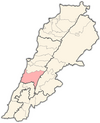Damour
This article has multiple issues. Please help improve it or discuss these issues on the talk page. (Learn how and when to remove these template messages)
|
Damour
الدامور | |
|---|---|
City | |
UTC+3 (EEST) | |
| Dialing code | +961 |
| Website | www.damour-lb.com |
Damour (
Geography
The city is located in one of the few flat areas of the Lebanese coast. It is built to the north of the river, the ancient Tamyrus, Highway separates the plantations. Now dismantled, the track is a stopover.
Climate
Damour has a mild mediterranean climate (Köppen climate classification: Csa).
| Climate data for Damour | |||||||||||||
|---|---|---|---|---|---|---|---|---|---|---|---|---|---|
| Month | Jan | Feb | Mar | Apr | May | Jun | Jul | Aug | Sep | Oct | Nov | Dec | Year |
| Mean daily maximum °C (°F) | 16.7 (62.1) |
17.2 (63.0) |
19.3 (66.7) |
22.4 (72.3) |
25.7 (78.3) |
28.4 (83.1) |
30.0 (86.0) |
30.5 (86.9) |
29.5 (85.1) |
27.2 (81.0) |
23.0 (73.4) |
18.9 (66.0) |
24.1 (75.3) |
| Daily mean °C (°F) | 13.2 (55.8) |
13.5 (56.3) |
15.2 (59.4) |
17.9 (64.2) |
21.2 (70.2) |
24.0 (75.2) |
25.9 (78.6) |
26.8 (80.2) |
25.5 (77.9) |
23.0 (73.4) |
18.9 (66.0) |
14.3 (57.7) |
20.0 (67.9) |
| Mean daily minimum °C (°F) | 9.8 (49.6) |
9.8 (49.6) |
11.3 (52.3) |
13.4 (56.1) |
16.7 (62.1) |
19.7 (67.5) |
21.9 (71.4) |
22.7 (72.9) |
21.5 (70.7) |
18.8 (65.8) |
14.8 (58.6) |
11.7 (53.1) |
16.0 (60.8) |
| Average precipitation mm (inches) | 200 (7.9) |
150 (5.9) |
108 (4.3) |
50 (2.0) |
17 (0.7) |
1 (0.0) |
0 (0) |
1 (0.0) |
6 (0.2) |
38 (1.5) |
102 (4.0) |
161 (6.3) |
834 (32.8) |
| Source: Climate-Data.org[4] | |||||||||||||
Churches
There exist six
Tourism
Because Damour is one of the few cities of the Lebanese coast having a sand beach, and since it is ten minutes from
History

In the 19th century, Damour was the a flourishing center of the
During the last centuries, Damour was located on the central axis of fighting and successive wars.
In 1302, after the Mamluks took Arwad Island, on 8 June the same year, the Cypriots landed on the Damour River. A battle took place between the Emir Fakhr al - Din Abdel - Hamid bin Jamaluddin Altnokhi, his brother the Emir Shams al - Din Abdullah accompanied by an army of Muslims against the Cypriot. The battle was won by Crusaders. Fakhr Din Emir was killed, while his brother Shams al - Din fell hostage. He was released after five days for a ransom of three thousand dinars tyriens.
In May 1860,
During the nights of the first world war, inhabitants met the armoured French cruiser Jeanne d'Arc sailors and received medicines, food and other needed supplies.
In 1941, Damour was the French administrative capital. The city being a strategic crossing point on the road to
In 1942, South African army engineers built a railway line from Haifa to Beirut along the coast and Australian engineers continued the line to Tripoli. <Orpen N & Martin H J. Salute the Sappers, part 1. 1981 Johannesburg.
On January 9, 1976, Palestinians laid siege to the city. On January 20, 1976, thousands of Palestinians committed a massacre of the inhabitants. See
During Israeli invasion of 1982, the Israeli air force bombed the city which was under the control of the Palestinian militias.
During the Israeli conflict of 2006, the Israeli air force destroyed several bridges on Highway Beirut-Tyre and on the Damour River.
The Historical Bridge
The history of the archeological bridge dates back to the era of prince-Béchir Shehab who had a great interest in it, it was considered a strategic and important transit point between Mt Lebanon and the South.[citation needed]
Neighborhoods
- Mar Thecla El Naame
- Mar Mikhael Al Damour
- Khiyam Al Damour
- Saadiyat
- Ghandouriyeh
- Missiar
Notable People
- Ghada Georges Aoun
- Elie Saab
- Nassib Al Matni (Journalist killed 1958)
- Michel Aoun
- Georges Akl
- Rose Ghorayeb - renowned Lebanese author and literary critic
- Michel Farid Ghrayeb
- Georges Asaad Aoun
- Aziz Al Matni (Journalist/writer)
- Marwan Al Matni (Journalist)
- Said Ghorayeb (Journalist/Television Presenter)
- Michel Azzi (Television Presenter)
- Michel Azzi (Singer)
- Nadine Saab (Singer)
- Joseph Hashem - Zaghloul al-Damour (Zajal Poet)
- Geryes Boustani (Zajal Poet)
- Mario Aoun (Minister)
- Dani Fadel (Scientific Researcher)
Gallery
- Damour views
See also
- Damour river
- Battle of Damour (1941)
- Damour massacre
- Damour notable natives
References
- ^ Lazkani, Souad (2021-01-18). "15+ Facts You Should Know About Damour In Lebanon". The961. Retrieved 2021-06-18.
- ^ Travels in Palestine and Syria, Volume 1, page 286 By George Robinson
- ^ "الموقع الرسمي لبلدية الدامور" (in Arabic). Archived from the original on 2012-01-25. Retrieved 2011-11-05.
- ^ "Climate: Damour". November 2011.
Bibliography
- ISBN 978-0233985169
External links
- Damour Archived 2017-03-28 at the Wayback Machine, Localiban



